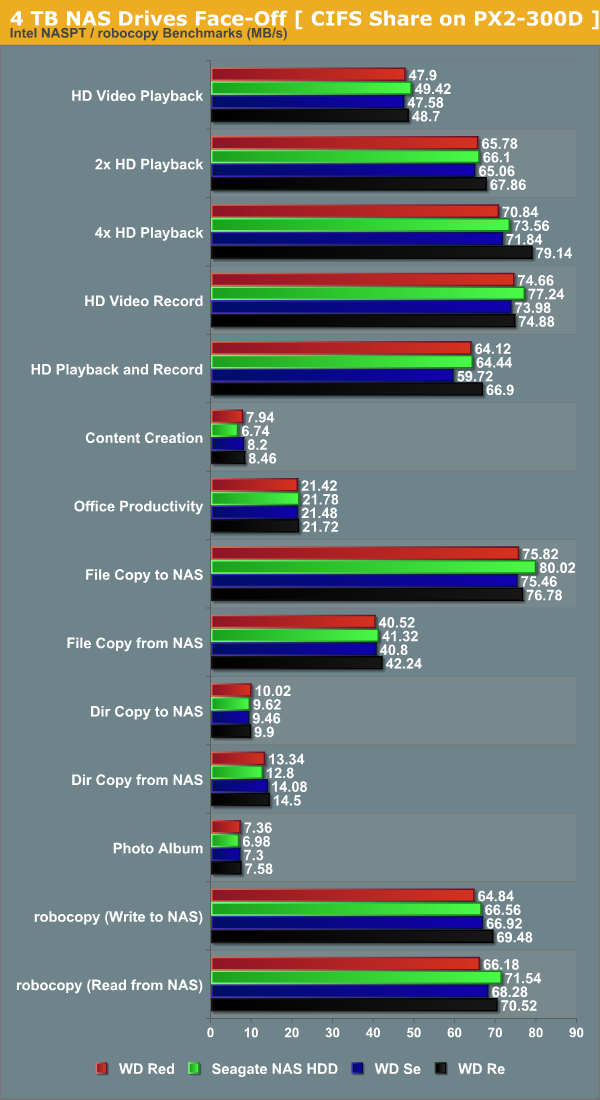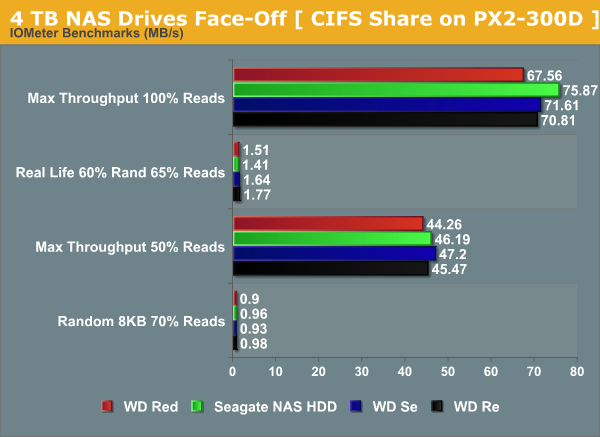Battle of the 4 TB NAS Drives: WD Red and Seagate NAS HDD Face-Off
by Ganesh T S on September 4, 2013 6:00 AM EST- Posted in
- NAS
- Seagate
- HDDs
- Western Digital
- Enterprise
Performance - Networked Environment
LenovoEMC's PX2-300D (based on the Intel Atom D525) was used as the testbed for evaluating the performance of the drives in a NAS enclosure. The PX2-300D is a 2-bay NAS unit. Only JBOD, RAID-0 and RAID-1 configurations are possible. Due to the lack of multiple samples of the Seagate NAS HDD, we restricted ourselves to evaluating a single disk configuration (JBOD) over the network A CIFS share was set up on the NAS and mapped on a Windows 7 VM. Intel NASPT / robocopy as well as IOMeter traces were run on this CIFS share.
Intel NASPT / robocopy

As expected, the WD Re takes the lead in many of the benchmarks. However, the Seagate NAS HDD is no slouch, and actually manages to hold its own in most of them (in fact, the read performance is pretty decent in this configuration).
IOMeter

IOMeter provides even more interesting results. The Seagate NAS HDD actually surpasses the WD Red in three of the four benchmark runs. That said, performance is only half the story in the 1-5 bay NAS market. Power consumption is also a very important metric. How much of a penalty do we have for the increased performance? The next section provides us some answers.










54 Comments
View All Comments
joelypolly - Wednesday, September 4, 2013 - link
With a difference of 1 to 2 watts for the Seagate I fail to see how that would be too much of a cause for concern for cooling systems? Even with a 5 disk array it should still be under 10 watts difference in the most demanding circumstances and about 5 watts on average.owan - Wednesday, September 4, 2013 - link
I was thinking about that. 1W difference has got to be negligible for any desktop based system. Even 3-4W differences, while large on the relative scale, are small in the absolute sense. I don't see how you could make the statement "if you want more performance, Seagate, if you need cool and quiet, WD" Is there no other reason to pick one drive over the other besides a 1W performance consumption difference?glugglug - Wednesday, September 4, 2013 - link
It is hard to see the relative differences quickly switching between the performance graphs for the different drives because some of them are on different scales for each drive. Is there any way the graph scales can be made uniform?ganeshts - Wednesday, September 4, 2013 - link
Can you let me know the specific graphs you are seeing the problem in? The numbers are also reported by HD Tune Pro on the side..glugglug - Wednesday, September 4, 2013 - link
The random read and random write graphs.I can see the scale on the side, but for example the random read graph has the max Y scale value at 50ms for the WD SE drive, 100ms for the Red drive and WD RE and 200 ms for the Seagate. At first glance, it looks like the Seagate is owning because of the scale -- it requires extra thought to figure out what the graph would look like on the same scale for comparison.
ganeshts - Wednesday, September 4, 2013 - link
Got it. From what I remember, HD Tune Pro doesn't give user control over graph scales. But, I will see what can be done for future articles.ZRohlfs - Wednesday, September 4, 2013 - link
If you look closely at those graphs you can see some outliers that are very high on the graph. They are away from the statistical clump but they cause the graph to have the scales that they do.carlwu - Wednesday, September 4, 2013 - link
Can anyone comment on Seagate reliability as of late? Their 1TB drive fiasco left a bad taste my mouth.dawza - Wednesday, September 4, 2013 - link
The Seagate NAS HDDs seem quite good in terms of reliability thus far. I have a 3 TB and 4 TB in my WHS (JBOD) and they've made it past the crucial 1 month mark without issues. But as mentioned in the review, these haven't been on the market very long.These are the first Seagates I've purchased in years due to past issues you alluded to.
RealBeast - Thursday, September 5, 2013 - link
Carlwu, I had that thought also but set up one NAS with 8 x 3TB Seagate 7200rpm (the ST3000DM001) in RAID 6 and have had no issues for the six months they have run 24/7. Fingers crossed.